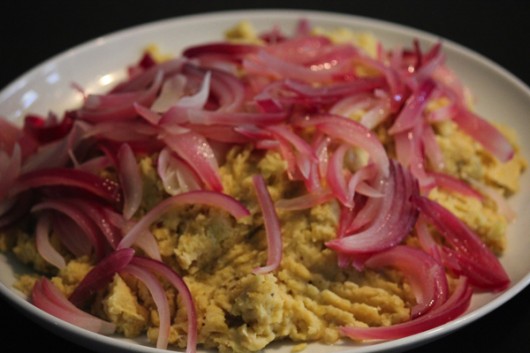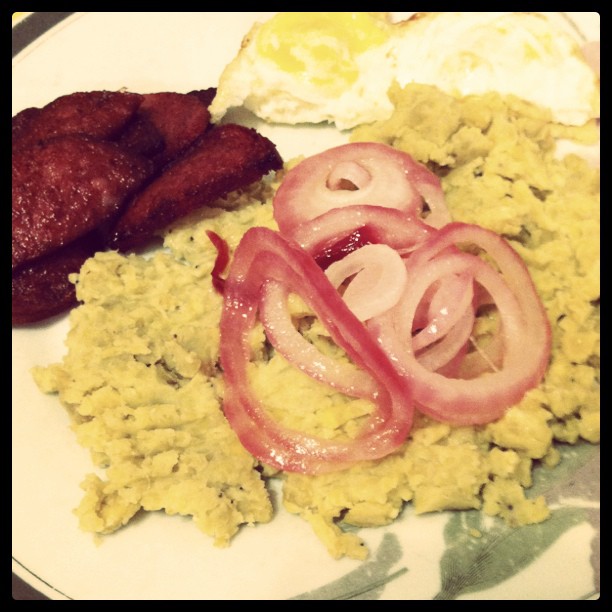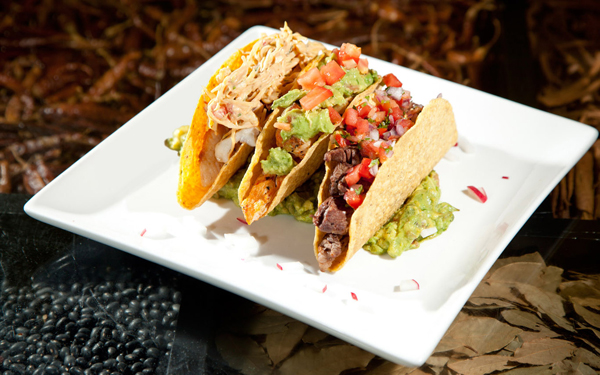BY Led Black (@Led_Black)

MANGU! The very word makes me and countless other Quisqueyanos salivate. For those that don’t know, mangu is the Dominican breakfast par excellence. Mangu is basically boiled, mashed green plantains with olive oil and a few others ingredients but that description doesn’t properly convey the magic of this staple of Dominican cuisine. Pair the mangu with fried cheese, eggs and Dominican Salami (AKA Los Tres Golpes) and you have a meal that is simple yet sublime. I would be remiss if I didn’t mention the vinegar soaked cooked onions that elevate the mangu to a work of gastronomic art.
I find it hilarious that Mangu Y Los Tres Golpes sounds like an awesome name for a band. By the way, there is a forth, less respected member of that group which is longaniza (Dominican sausage). I would also like to mention that some folks enjoy a mangu made from ripe yellow plantains but I do not count myself as part of that contingent. I like my mangu from green plantains strictly. I guess you can call me a traditionalist.
At the Platano Festival, yes – you heard that correct – The Platano Festival, which is an actual yearly event in Washington Heights, I was introduced to 2 possible origins for the word mangu. The first I had heard before but I find the least credible. According to this theory, during the first American occupation of the Dominican Republic which began in 1916, an American soldier tasted the concoction and said “man good!”, Dominicans heard that and ran with it and enshrined it as the name for the culinary concoction. I highly doubt that the word mangu has been around for less than a hundred years. Nevertheless, it is accepted wisdom that this is the real origin of the word.
The second theory, which I am much more inclined to believe, is that the term is of African origin. According to a gentleman who spoke at the festival, mangu originates with Africans from the Congo region who came to the island during the height of the slave trade. The man stated the original word was something akin to mangusi and referred to almost any root vegetable that was boiled and mashed. He also derided Dominicans for their denial of their African roots and stated that self-hatred was the reason that the other theory is more widely accepted. He also said that mangu is remarkably similar to the West African foo foo, which is undeniable. Whichever theory you subscribe to, there is no argument that mangu is one of the cornerstones of Dominican cuisine and is the preferred breakfast dish of Dominicans on the island and in the Diaspora. Long live mangu!
Also check out: I Love Platanos – An Ode to Platanos & Briana’s Pics of the Platano Fest
This excerpt is an adaptation from my as of yet unpublished DR Travelogue, which is my heart-felt ode to the Dominican Republic. DR Travelogue is a native son’s poignant and hilarious journey to the heart, soul and soil of the Dominican Republic.
We invite you to subscribe to the weekly Uptown Love newsletter, like our Facebook page and follow us on Twitter, or e-mail us at [email protected].




The SPEACH » Mangu 2.0
April 24, 2012 at 9:29 am[…] Here’s another take on the “traditional” mangu meal: The Magnificent Mangu […]
Peter Nero
May 13, 2015 at 4:02 pmBy 1916, Dominicans had been eating mangu for 300 years or more, so why is this theory about a (probably white) soldier from the U.S. so widely accepted?
Did Dominicans really need an outsider to come and name one of their staple foods for them? That sounds like some Trujillo installed nonsense.
Jen
August 15, 2018 at 10:54 amIt makes sense. If you research history, platanos did not grow in DR, PR or Cuba. It was brought by the African slaves to the islands along with their dishes as well. Just like the Mofongo.